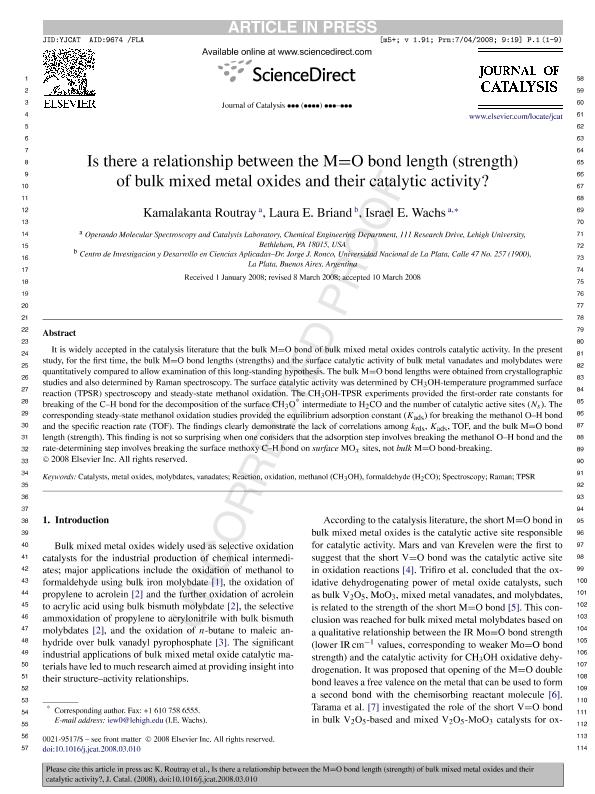Mostrar el registro sencillo del ítem
dc.contributor.author
Routray, Kamalakanta
dc.contributor.author
Briand, Laura Estefania

dc.contributor.author
Wachs, Israel E.
dc.date.available
2017-05-18T18:23:38Z
dc.date.issued
2008-03-10
dc.identifier.citation
Routray, Kamalakanta; Briand, Laura Estefania; Wachs, Israel E.; Is there a relationship between the M=O bond length (strength) of bulk mixed metal oxides and their catalytic activity?; Elsevier; Journal Of Catalysis; 256; 1; 10-3-2008; 145-153
dc.identifier.issn
0021-9517
dc.identifier.uri
http://hdl.handle.net/11336/16649
dc.description.abstract
It is widely accepted in the catalysis literature that the bulk M=O bond of bulk mixed metal oxides controls catalytic activity. In the present study, for the first time, the bulk M=O bond lengths (strengths) and the surface catalytic activity of bulk metal vanadates and molybdates were quantitatively compared to allow examination of this long-standing hypothesis. The bulk M=O bond lengths were obtained from crystallographic studies and also determined by Raman spectroscopy. The surface catalytic activity was determined by CH3OH-temperature programmed surface reaction (TPSR) spectroscopy and steady-state methanol oxidation. The CH3OH-TPSR experiments provided the first-order rate constants for breaking of the C?H bond for the decomposition of the surface CH3O* intermediate to H2CO and the number of catalytic active sites Ns. The corresponding steady-state methanol oxidation studies provided the equilibrium adsorption constant Kads for breaking the methanol OH bond and the specific reaction rate (TOF). The findings clearly demonstrate the lack of correlations among krds, Kads, TOF, and the bulk M=O bond length (strength). This finding is not so surprising when one considers that the adsorption step involves breaking the methanol OH bond and the rate-determining step involves breaking the surface methoxy CH bond on surface MO sites, not bulk M=O bond-breaking.
dc.format
application/pdf
dc.language.iso
eng
dc.publisher
Elsevier

dc.rights
info:eu-repo/semantics/openAccess
dc.rights.uri
https://creativecommons.org/licenses/by-nc-nd/2.5/ar/
dc.subject
Catalists
dc.subject
Metal Oxide
dc.subject
Molybdates
dc.subject
Vanadates
dc.subject
Reaction
dc.subject
Methanol (Ch3oh)
dc.subject
Oxidation
dc.subject
Formaldehyde (H2co)
dc.subject
Spectroscopy
dc.subject
Raman
dc.subject
Tpsr
dc.subject.classification
Ingeniería de los Materiales

dc.subject.classification
Ingeniería de los Materiales

dc.subject.classification
INGENIERÍAS Y TECNOLOGÍAS

dc.title
Is there a relationship between the M=O bond length (strength) of bulk mixed metal oxides and their catalytic activity?
dc.type
info:eu-repo/semantics/article
dc.type
info:ar-repo/semantics/artículo
dc.type
info:eu-repo/semantics/publishedVersion
dc.date.updated
2017-05-17T13:50:24Z
dc.journal.volume
256
dc.journal.number
1
dc.journal.pagination
145-153
dc.journal.pais
Países Bajos

dc.journal.ciudad
Amsterdam
dc.description.fil
Fil: Routray, Kamalakanta. Lehigh University. Chemical Engineering Department, Operando Molecular Spectroscopy and Catalysis Laboratory; Estados Unidos
dc.description.fil
Fil: Briand, Laura Estefania. Consejo Nacional de Investigaciones Científicas y Técnicas. Centro Científico Tecnológico Conicet - la Plata. Centro de Investigación y Desarrollo En Ciencias Aplicadas "dr. Jorge J. Ronco". Universidad Nacional de la Plata. Facultad de Ciencias Exactas. Centro de Investigación y Desarrollo En Ciencias Aplicadas; Argentina
dc.description.fil
Fil: Wachs, Israel E.. Lehigh University. Chemical Engineering Department, Operando Molecular Spectroscopy and Catalysis Laboratory; Estados Unidos
dc.journal.title
Journal Of Catalysis

dc.relation.alternativeid
info:eu-repo/semantics/altIdentifier/url/http://www.sciencedirect.com/science/article/pii/S0021951708001061
dc.relation.alternativeid
info:eu-repo/semantics/altIdentifier/doi/http://dx.doi.org/10.1016/j.jcat.2008.03.010
Archivos asociados
